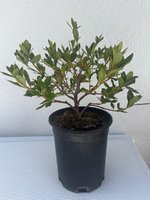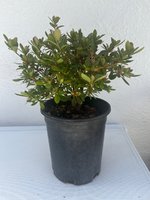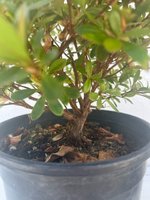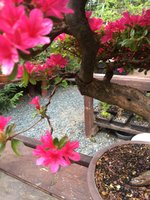kekoa
Sapling
I'm looking for advice for next steps to consider for these two young satsuki azaleas. I'm in SoCal (Zone 10a) and both of these have already flowered and I've removed the pistils.
The first is a Kinpai i purchased earlier this spring. This view represents a good "front" side i think, and after removing the pistils I also lightly pruned some of the vertical branches as well as branches that were crossing the trunk with regards to this view. The trunk is 2 cm at the thickest, which still seems rather small to me. I'd like to thicken the trunk but also add movement. While i'd like to wire in movement in some of the primary branches, I'm concerned about breakage and also whether it's too early to consider that kind of refinement when the trunk might need 1-2 years to thicken meaning these branches will all likely be pruned away by then.

The second tree is a Tama no Hada. It has a slightly thicker trunk measuring about 2.5 cm at the thickest visible. This view is my preferred front for the time being. While i've removed pistils from spent flowers, i've done less pruning. My goals for this tree are the same as the Kinpai: I want to further thicken the trunk and what research i've done seems to point to putting it in the ground. However, i'm again unsure about what to do with the branches at this moment. Wire them to establish some preliminary shape or just maintenance prune while i wait for the trunk to thicken and then work on the shape later.


Any/add comments, advice, and feedback welcome! Thanks.
The first is a Kinpai i purchased earlier this spring. This view represents a good "front" side i think, and after removing the pistils I also lightly pruned some of the vertical branches as well as branches that were crossing the trunk with regards to this view. The trunk is 2 cm at the thickest, which still seems rather small to me. I'd like to thicken the trunk but also add movement. While i'd like to wire in movement in some of the primary branches, I'm concerned about breakage and also whether it's too early to consider that kind of refinement when the trunk might need 1-2 years to thicken meaning these branches will all likely be pruned away by then.

The second tree is a Tama no Hada. It has a slightly thicker trunk measuring about 2.5 cm at the thickest visible. This view is my preferred front for the time being. While i've removed pistils from spent flowers, i've done less pruning. My goals for this tree are the same as the Kinpai: I want to further thicken the trunk and what research i've done seems to point to putting it in the ground. However, i'm again unsure about what to do with the branches at this moment. Wire them to establish some preliminary shape or just maintenance prune while i wait for the trunk to thicken and then work on the shape later.


Any/add comments, advice, and feedback welcome! Thanks.







